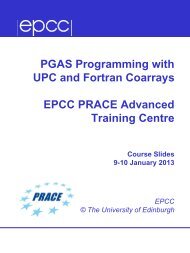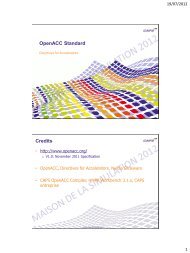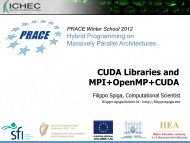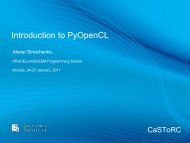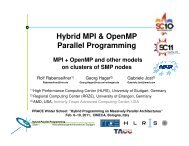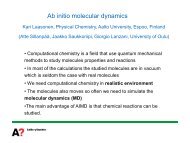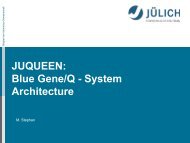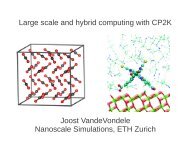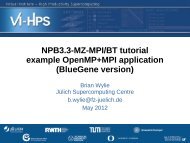Molecular Simulation Methods with Gromacs
Molecular Simulation Methods with Gromacs
Molecular Simulation Methods with Gromacs
You also want an ePaper? Increase the reach of your titles
YUMPU automatically turns print PDFs into web optimized ePapers that Google loves.
Question: Look at the error bars for the individual ! points: they vary a lotbetween individual point pairs. What does this mean for the efficiency for theoverall calculation? How could it be improved?Where to go from hereAfter calculating the free energy of solvation, we’ve solved the first part of the freeenergy of binding of Eq. 2. The second part involves coupling a molecule into (or out of)a situation where it is bound to a protein. This introduces one additional complexity: weend up <strong>with</strong> a situation where a weakly coupled ligand wanders through our system:LPLPPLwhich is bad because this is a poorly reversible situation: there are suddenly very fewstates that map from a weakly coupled to a more strongly coupled molecule, which willdrastically reduce the accuracy of the free energy calculation.This situation can be remedied by forcing the ligand to stay at a specific positionrelative to the protein. This can be done <strong>with</strong> the <strong>Gromacs</strong> ‘pull code’, which allows thespecification of arbitrary forces or constraints onto <strong>with</strong> respect to centers of mass of anychosen set of atoms onto any other group of atoms. With a pull type of ‘umbrella’, wecan specify that we want a quadratic potential to this specified location, forcing theligand to stay at its native position even when it has been fully de-coupled.One way find out where to put the center of the force is by choosing a group of atomsin the protein close to the ligand, and doing a simulation <strong>with</strong> full ligand coupling,where the pull code is enabled, but <strong>with</strong> zero force. The pull code will then frequentlyoutput the coordinates of the ligand, from which an average position and an expecteddeviation can be calculated. This can then serve as a reference point for the location ofthe center of force for the pull code during the production runs, and the force constantof the pull code.Once the free energy has been calculated, care must be taken to correct for the factthat we have trapped our molecule. This can easily be done analytically.Optional Question: Given a measured standard deviation in the location of thecenter of mass of our ligand, how do we choose the force constant for the pullcode?



